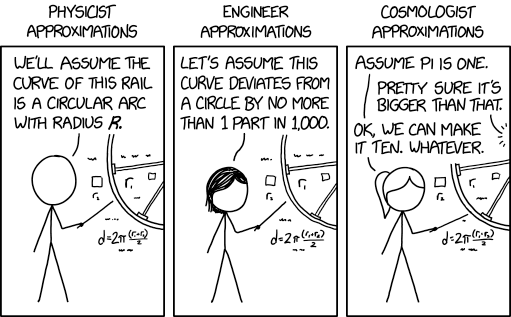Difference between revisions of "2205: Types of Approximation"
(Frist stab at explanation) |
(→Explanation) |
||
| Line 9: | Line 9: | ||
==Explanation== | ==Explanation== | ||
{{incomplete|Created by an APPROXIMATOR. Please mention here why this explanation isn't complete. Do NOT delete this tag too soon.}} | {{incomplete|Created by an APPROXIMATOR. Please mention here why this explanation isn't complete. Do NOT delete this tag too soon.}} | ||
| − | |||
Different professions deal with approximations differently. | Different professions deal with approximations differently. | ||
| − | A Physicist, generally dealing with straight math, attempts to reference the physical object by the appropriate mathematical formula, in this case involving the mathematical constant Pi, which is used to describe perfect circles. | + | A Physicist, generally dealing with straight math, attempts to reference the physical object by the appropriate mathematical formula, in this case involving the mathematical constant Pi, which is used to describe perfect circles. So the assumption is strictly that of which mathematical model to use. |
An Engineer, dealing with physical objects, knows it's impossible to meet the ideal of a perfect circle, so they measure the imperfections by small variations from the ideal. | An Engineer, dealing with physical objects, knows it's impossible to meet the ideal of a perfect circle, so they measure the imperfections by small variations from the ideal. | ||
Revision as of 20:19, 20 September 2019
| Types of Approximation |
 Title text: It's not my fault I haven't had a chance to measure the curvature of this particular universe. |
Explanation
| |
This explanation may be incomplete or incorrect: Created by an APPROXIMATOR. Please mention here why this explanation isn't complete. Do NOT delete this tag too soon. If you can address this issue, please edit the page! Thanks. |
Different professions deal with approximations differently.
A Physicist, generally dealing with straight math, attempts to reference the physical object by the appropriate mathematical formula, in this case involving the mathematical constant Pi, which is used to describe perfect circles. So the assumption is strictly that of which mathematical model to use.
An Engineer, dealing with physical objects, knows it's impossible to meet the ideal of a perfect circle, so they measure the imperfections by small variations from the ideal.
A Cosmologist, used to dealing with distances of lightyears (i.e. millions and billions of miles), often round figures pretty drastically on the low end to simplify math, knowing that at the high end those differences will be negligible. The humor is that rounding Pi to 1 or 10 completely defeats the purpose of Pi for describing a circle.
Transcript
| |
This transcript is incomplete. Please help editing it! Thanks. |
[There are three panels, each labeled on top]
[Physicist Approximations]
- Cueball: We'll assume the curve of this rail is a circular arc with radius R.
[Engineer Approximations]
- Megan: Let's assume this curve deviates from a circle by no more than 1 part in 1,000.
[Cosmologist Approximations]
- Ponytail: Assume pi is one.
- Off-panel voice: Pretty sure it's bigger than that.
- Ponytail: OK, we can make it ten. Whatever.
Discussion
The cosmologist is probably using Fermi's a la What-If 84: Paint the EarthOhFFS (talk) 20:34, 20 September 2019 (UTC)
- In that What-If, the rounding formula for Fermi problem estimation is given as "Fermi(x) = round10(log10(x))". log10(pi) (Google search, shows calculator) is roughly .4971... so close enough that someone could do a "Fermi rounding" to either 1 or 10 and not really care one way or another. 162.158.142.118 21:19, 20 September 2019 (UTC)
As a physics Phd (though not working in astrophysics), approximating pi to 1 is not all that bad. Especially when the measurable quantities that go into the calculation usually have huge error bars.--172.68.59.120 21:03, 20 September 2019 (UTC)
Using natural units (setting c=hbar=1) is different from setting pi to 1. Using different units is always allowed and not an approximation. Setting pi to 1 on the other hand, is an approximation and is only justifiable if the other quantities in the calculation have huge uncertainty. --172.68.59.120 21:07, 20 September 2019 (UTC)
